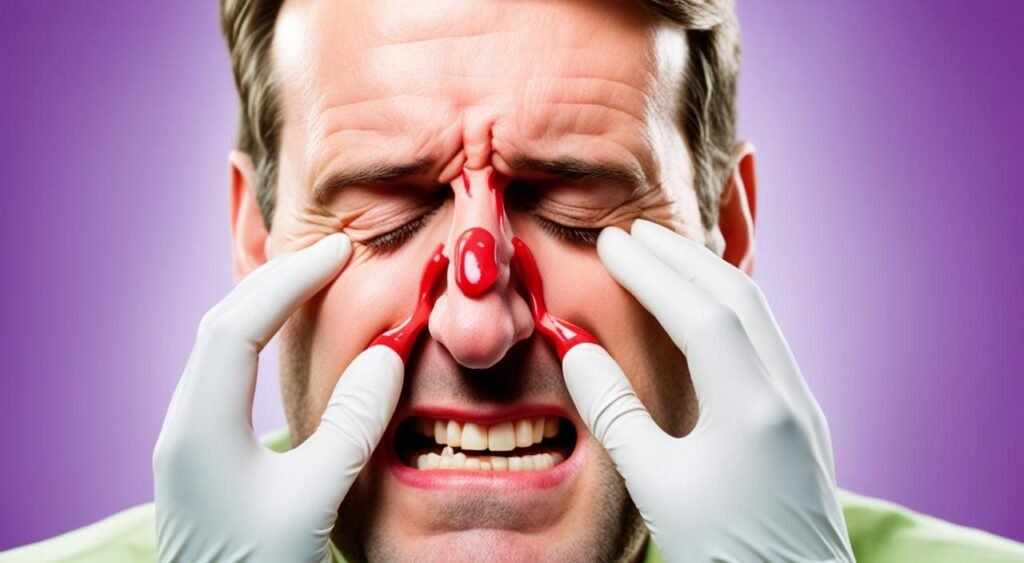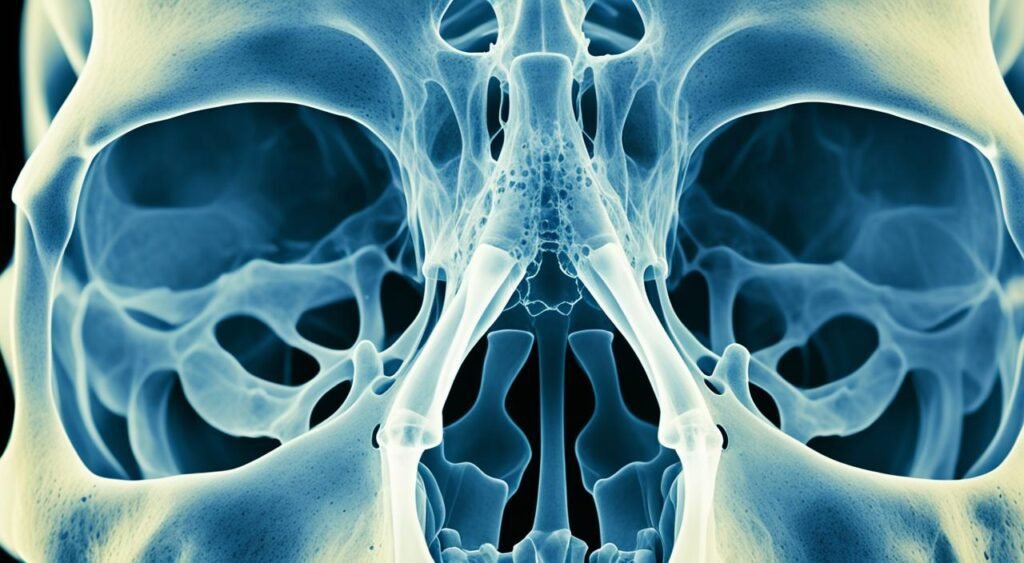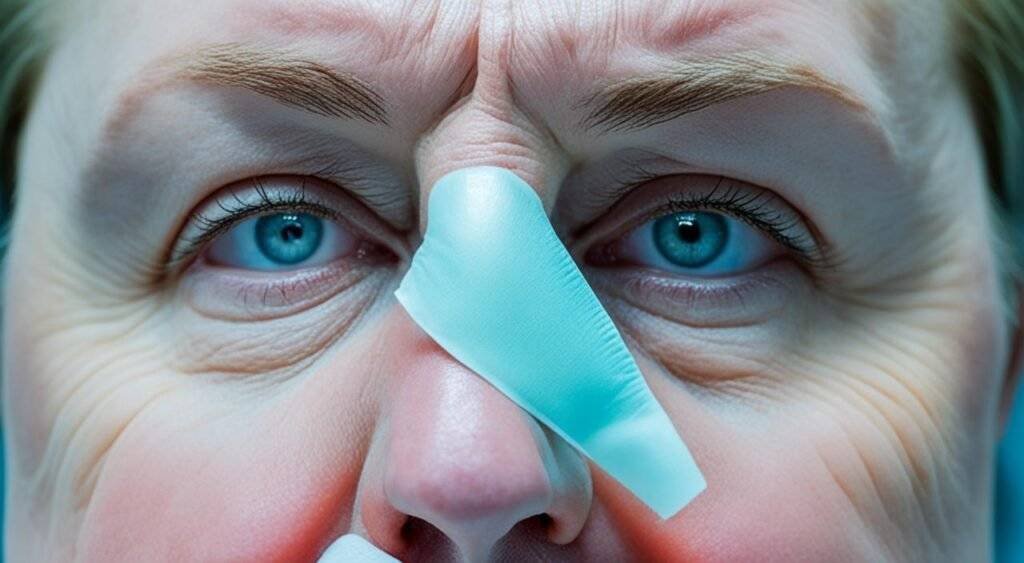Have you ever thought that the pain after a tooth extraction could be from a perforated sinus? This often-overlooked issue can cause serious problems. When you have upper molars or wisdom teeth removed, there’s a risk of sinus perforation. Symptoms of perforated sinus after tooth extraction may include persistent pain, nasal discharge, or a feeling of air passing between your mouth and nose. It’s crucial to be aware of these signs to seek timely treatment and prevent complications.
It’s key to know the signs of a perforated sinus after tooth extraction. You might feel pain, have trouble breathing, or even bleed, which could mean dental issues affecting your sinuses. We’ll explore these symptoms and why it’s vital to spot them early for better care.
Understanding Sinus Perforation
Sinus perforation is key to know, especially with dental work. It’s crucial to understand what it is and its effects. This knowledge helps spot risks during treatments like pulling teeth. When working on upper teeth, the roots can be near the sinus cavity, causing a hole in the sinus membrane.
What is Sinus Perforation?
Sinus perforation means a hole in the sinus membrane. It can happen during dental work like pulling teeth or putting in implants. Knowing about it is important because not treating it can lead to ongoing sinus infections or sinusitis. The risk is higher when working on upper teeth because the sinus is close to the roots.
Causes of Sinus Perforation in Dental Procedures
There are several reasons why sinus perforation can happen during dental work. One big reason is the roots of upper teeth being close to the sinus floor. These roots are just behind a thin layer of bone or sinus mucosa. Getting X-rays before pulling teeth helps check the risk of sinus perforation.

If sinus perforation is not treated, it can cause ongoing sinus infections and sinusitis. Surgery is often needed for holes bigger than 6 mm to stop more problems. About 20% of tooth extractions lead to sinus perforations, showing why careful checks and informed consent are key before starting any dental work.
Symptoms of Perforated Sinus After Tooth Extraction
After getting a tooth pulled, especially in the upper jaw, you might notice certain signs related to a perforated sinus. It’s key to spot these signs early. Knowing the difference between normal healing pain and signs of a perforated sinus can help your recovery.
Pain and Discomfort
After a tooth extraction, you might feel ongoing pain and discomfort in your upper jaw. This pain often means your sinuses are involved. If the sinus gets perforated, it can make the pain worse, causing serious worry if the pain doesn’t go away.
Nasal Congestion and Runny Nose
Signs of a perforated sinus include nasal congestion and a runny nose. When air and bacteria get into the sinus through a hole, your body may make more mucus. This can cause a runny nose. These symptoms could mean you’re getting a sinus infection after the tooth extraction, so you should see a doctor.
Bleeding from the Nose
Bleeding from the nose is another worrying sign. If you see this along with other symptoms, you should get medical help right away. It could mean serious problems. Watching for these signs of a perforated sinus after tooth extraction is key to getting help on time.

| Symptom | Description |
|---|---|
| Pain and Discomfort | Radiating pain in the upper jaw and sinus area. |
| Nasal Congestion | Blocked nasal passages resulting in difficulty breathing. |
| Runny Nose | Mucus discharge, often indicating potential sinus infection. |
| Bleeding from the Nose | Unexpected nasal bleeding requiring prompt medical evaluation. |
Signs of Sinus Perforation After Dental Procedure
It’s key to know the signs of sinus perforation after dental work. These symptoms can go beyond just pain. They show more serious sinus problems.
Changes in Sense of Smell and Taste
After a dental procedure, you might notice changes in how you smell things. Trouble smelling odors could mean you have a sinus perforation. This can also affect how you taste food, making it less enjoyable.
Noticing these changes in smell is a clue to see a doctor.
Postnasal Drip
Postnasal drip is another clue of sinus perforation. It happens when mucus builds up in the sinuses and flows down the back of your throat. This can be very uncomfortable and might make other symptoms worse if not treated.
Diagnosing Sinus Perforation
Diagnosing sinus perforation takes a detailed look at your medical history and a thorough check-up. Knowing about recent dental work helps understand possible issues. A clinical exam may check for signs like nasal discharge, swelling, or pain that suggest a perforation.
Clinical Examination and Medical History
Your dentist or oral surgeon will start by talking about your medical history, especially any past sinus problems or symptoms. They will look for signs of sinus perforation during a physical check-up. These signs include:
- Nasal discharge
- Facial swelling
- Dull or sharp nasal pain
Spotting these signs early helps start treatment quickly. This can reduce risks of further problems.
Imaging Techniques for Diagnosis
Imaging tools like CBCT and X-rays are also key in diagnosing sinus perforation. They help see the damage clearly. These tests are crucial if removing a tooth might affect the sinus. They show:
- The exact position of the tooth
- Potential complications near sinus structures
Using these imaging tools helps doctors find the best way to treat sinus perforation.
Treatment for Sinus Perforation
Treatment for sinus perforation depends on the size and symptoms. Small or symptom-free perforations might be managed conservatively. This means watching closely and using antibiotics to prevent infections. For bigger or painful perforations, more serious steps are needed.
Conservative Management Options
Managing sinus perforation without surgery can work well. Important steps include:
- Watching the perforation closely.
- Using antibiotics to lower infection risk, as advised by dental experts.
- Avoiding nose blowing, sneezing hard, and using straws.
- Using nasal decongestants like Afrin Spray or Sudafed ER to reduce congestion.
- Eating soft or liquid food and chewing on the opposite side of the mouth.
Following these steps can help you heal without surgery.
Surgical Interventions
If conservative methods don’t work, surgery may be needed. Surgery can include:
- Closing the sinus openings with stitches or other materials during surgery.
- Doing a sinus lift if sinus exposure happens during dental work.
- Fixing the membrane that separates the sinus from the dental area. This might involve working with ENT specialists for complex cases.
Getting help from oral surgeons or ENT experts can improve recovery chances, especially for complex cases. Following the treatment plan and listening to your doctors is key to a good outcome.
| Factors | Conservative Management | Surgical Interventions |
|---|---|---|
| Size of Perforation | Small or Asymptomatic | Larger or Symptomatic |
| Monitoring | Regular Check-ups | Immediate Intervention Required |
| Antibiotic Therapy | Prescribed as Needed | Post-surgery to Prevent Infection |
| Post-operative Care | Guidelines to Follow | Specific Recovery Instructions |
Sinus Communication After Dental Surgery
It’s important to know about sinus communication after dental surgery for your health. This can happen, especially after pulling upper molars, due to a thin bone between the sinus and tooth socket. If not caught early, it can lead to serious issues like chronic sinusitis and recurring infections.
Complications of Undiagnosed Perforation
Not spotting and treating sinus communication can cause big problems. Bacteria from your mouth can get into the sinus, causing an infection. Also, blood from the tooth socket might go into the sinus, making your nose or throat discharge look discolored.
Try not to do things that make sinus pressure worse, like using straws or blowing your nose hard. This can help avoid these issues.
Collaboration with Healthcare Professionals
Working together with different healthcare experts is key to handling sinus communication issues. This means talking to ENT specialists and others for the best care. Regular check-ups can keep an eye on healing and spot problems early.
Good communication between dental and medical teams also helps improve treatment results.
Management of Sinus Perforation
After treatment for sinus perforation, it’s key to take good care of yourself. Proper care helps healing and prevents new problems. This part will cover what you need to do after treatment and how to avoid more issues.
Post-Treatment Care and Follow-Up
How you care for yourself after sinus perforation treatment affects your healing. Stick to any medicines your doctor gives you, like antibiotics to fight infection and painkillers. Eating soft foods helps healing tissues recover without extra strain. Avoid doing things that put pressure on your nasal passage, like hard exercise or blowing your nose too much. Regular check-ups with your dentist are important to watch your healing and fix any problems early.
Prevention of Further Complications
Preventing more problems depends on what you do next. Knowing the risks of sinus perforation helps you make better choices after treatment. Stay away from smoke and keep your mouth clean, and don’t do things that bother the treated area. If you notice more pain or bleeding, get help right away. Understanding how to manage sinus perforation helps you stay healthy after dental work.
| Care Aspect | Recommendations |
|---|---|
| Medication | Follow prescribed antibiotic and pain relief regimens. |
| Diet | Consume a soft diet to aid recovery. |
| Follow-Up | Attend regular follow-up appointments for monitoring. |
| Hygiene | Maintain good oral hygiene, avoiding pressure activities. |
| Awareness | Be vigilant for signs of complications (e.g., pain, bleeding). |
Conclusion
Understanding the symptoms of perforated sinus after tooth extraction is key. It’s important to know the signs like pain, bleeding, and changes in senses after dental work. This knowledge helps in taking care of your oral health and overall well-being.
This article covered how to spot, diagnose, and treat sinus perforations. With the right knowledge, you can prevent problems from dental work. It’s vital to keep up with follow-up appointments to help your sinus perforations heal properly.
Talk to your dental healthcare provider to find the best plan for you. Putting your health first and knowing about sinus perforation helps avoid future issues. This way, you can support your healing after dental procedures.
FAQ
What are the symptoms of perforated sinus after tooth extraction?
Symptoms include pain in the upper jaw, nasal congestion, a runny nose, and bleeding from the nose or mouth. It’s key to spot these symptoms early for proper care.
How is sinus perforation diagnosed?
Doctors use a clinical exam, your medical history, and imaging like CBCT scans to diagnose sinus perforation. This helps see how big the hole is.
What treatment options are available for sinus perforation?
Treatment depends on how big the hole is. Small holes might just need watching and antibiotics. Bigger holes might need surgery to close them up.
What signs may indicate a sinus perforation after dental procedures?
Look out for changes in smell or taste, and postnasal drip. These could mean you have an infection or inflammation that needs a doctor’s check-up.
Can I experience a sinus infection after tooth extraction?
Yes, you can get a sinus infection after tooth extraction. This happens if bacteria get into the sinus through a hole from the mouth.
How can I manage sinus perforation after a dental procedure?
Follow your dentist’s advice on care, like taking your meds, eating soft foods, and going to check-ups. This helps your mouth heal right.
What complications can arise from an undiagnosed sinus perforation?
Not finding and treating a perforation can lead to chronic sinusitis and ongoing infections. It’s crucial to see a doctor quickly if you have symptoms.
Are there preventive measures for sinus perforation during dental surgery?
Yes, you can prevent it by getting a thorough check-up before surgery and being careful during procedures on upper molars or wisdom teeth.








